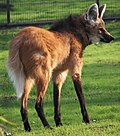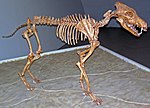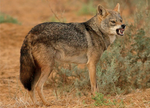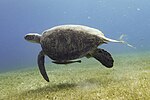 | The Beringian wolf is an extinct population of wolf (Canis lupus) that lived during the Ice Age. It inhabited what is now modern-day Alaska, Yukon, and... 76 KB (8,297 words) - 17:14, 16 April 2024 |
 | study found the Beringian wolf to be basal to all other grey wolves except for the extant Indian grey wolf and the extant Himalayan wolf. The Pleistocene... 76 KB (8,081 words) - 17:16, 16 April 2024 |
 | Eastern wolf can be found only in the Mexican wolf. The authors propose that Pleistocene coyote and Beringian wolf admixture led to the Eastern wolf long... 60 KB (7,377 words) - 18:54, 1 March 2024 |
 | The wolf (Canis lupus; pl.: wolves), also known as the gray wolf or grey wolf, is a large canine native to Eurasia and North America. More than thirty... 121 KB (13,474 words) - 02:44, 24 April 2024 |
 | extinct Beringian wolf was the ancestor of the southern wolf clade, which includes the Mexican wolf and the Great Plains wolf. The Mexican wolf is the... 11 KB (1,355 words) - 19:05, 18 March 2024 |
 | more likely from a wolf. Belgium 26,000 YBP has been found to be uniquely large but was found not to be related to the Beringian wolf. This Belgium canid... 81 KB (7,207 words) - 16:24, 25 April 2024 |
auks by John James Audubon (1827-1838). A drawing of a Falkland Islands wolf published in The Illustrated London News (1873). Only quagga photographed... 285 KB (18,521 words) - 11:37, 25 April 2024 |
 | The maned wolf (Chrysocyon brachyurus) is a large canine of South America. It is found in Argentina, Brazil, Bolivia, Peru, and Paraguay, and is almost... 49 KB (5,551 words) - 22:39, 26 April 2024 |
 | Domestication of the dog (redirect from Domestication of the wolf) now-extinct wolf population – or closely related wolf populations – which was distinct from the modern wolf lineage. The dog's similarity to the grey wolf is the... 163 KB (19,537 words) - 16:24, 25 April 2024 |
 | Beringia (section Beringian Gap) respective Siberian and North American portions of Beringia has led to the 'Beringian Gap' hypothesis, wherein an unconfirmed geographic factor blocked migration... 45 KB (5,892 words) - 00:22, 26 March 2024 |
 | branches led to the borophagine and canine radiations. Around 8 Mya, the Beringian land bridge allowed members of the genus Eucyon a means to enter Asia... 45 KB (5,069 words) - 15:32, 26 April 2024 |
 | Stoat (redirect from Beringian ermine) The stoat (Mustela erminea), also known as the Eurasian ermine, Beringian ermine and ermine, is a mustelid native to Eurasia and the northern regions... 46 KB (4,877 words) - 12:01, 27 April 2024 |
 | Coyote (redirect from Prairie wolf) smaller than its close relative, the gray wolf, and slightly smaller than the closely related eastern wolf and red wolf. It fills much of the same ecological... 154 KB (15,877 words) - 13:51, 26 April 2024 |
 | The African wolf (see below for other names; Canis lupaster) is a canine native to North Africa, West Africa, the Sahel, northern East Africa, and the... 66 KB (7,022 words) - 18:05, 27 April 2024 |
support to the "Beringian standstill" hypothesis — that the ancestors of Native Americans spent considerable time isolated in a Beringian refuge during... 10 KB (838 words) - 09:48, 29 December 2023 |
 | Panthera spelaea (redirect from Beringian cave lion) was restricted to Beringia during the Pleistocene. For this reason, the Beringian population is considered a distinct subspecies, P. s. vereshchagini. Lion-like... 43 KB (4,394 words) - 02:29, 24 April 2024 |
 | The Wolf Plains Group is a Late Adena culture group of 30 earthworks including 22 conical mounds and nine circular enclosures. The Plains, originally known... 6 KB (531 words) - 23:06, 4 April 2024 |













